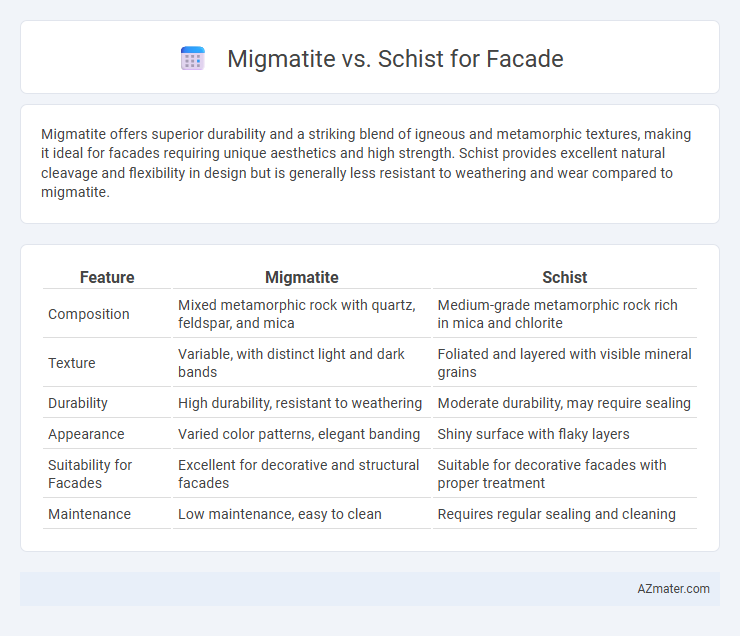Migmatite offers superior durability and a striking blend of igneous and metamorphic textures, making it ideal for facades requiring unique aesthetics and high strength. Schist provides excellent natural cleavage and flexibility in design but is generally less resistant to weathering and wear compared to migmatite.
Table of Comparison
| Feature | Migmatite | Schist |
|---|---|---|
| Composition | Mixed metamorphic rock with quartz, feldspar, and mica | Medium-grade metamorphic rock rich in mica and chlorite |
| Texture | Variable, with distinct light and dark bands | Foliated and layered with visible mineral grains |
| Durability | High durability, resistant to weathering | Moderate durability, may require sealing |
| Appearance | Varied color patterns, elegant banding | Shiny surface with flaky layers |
| Suitability for Facades | Excellent for decorative and structural facades | Suitable for decorative facades with proper treatment |
| Maintenance | Low maintenance, easy to clean | Requires regular sealing and cleaning |
Introduction to Migmatite and Schist
Migmatite features a unique blend of igneous and metamorphic rock, characterized by its mixed, banded appearance formed under high-temperature conditions, making it durable and visually dynamic for facade applications. Schist is a medium-grade metamorphic rock, recognized for its foliated texture and abundant mica content, providing a distinctive shimmer and ease of splitting into thin layers ideal for decorative cladding. Both materials offer natural stone aesthetics with Migmatite noted for its strength and irregular patterns, while Schist emphasizes layered textures and reflective qualities, influencing facade design choices.
Geological Formation and Composition
Migmatite forms through partial melting and metamorphic processes, resulting in a heterogeneous mixture of igneous and metamorphic components, primarily quartz, feldspar, and biotite. Schist is a foliated metamorphic rock characterized by well-aligned platy minerals such as mica, chlorite, and quartz, formed under moderate to high-grade metamorphic conditions. The compositional differences influence their durability and aesthetic appeal for facades, with Migmatite offering varied texture due to its mixed origin, while Schist provides consistent foliation and shimmer from its mineral alignment.
Physical Properties Relevant to Facades
Migmatite exhibits exceptional durability and high resistance to weathering, making it ideal for facades exposed to harsh environmental conditions, due to its mixed metamorphic and igneous composition. Schist, characterized by its pronounced foliation and lower compressive strength, may be more prone to splitting and erosion when used on exterior surfaces, though it offers aesthetic appeal with its distinctive layered texture. Both stones require consideration of porosity and mineral stability to ensure long-term facade performance under moisture and thermal cycling.
Durability and Weather Resistance
Migmatite offers exceptional durability and superior weather resistance compared to schist, making it ideal for building facades exposed to harsh environmental conditions. Its mixed metamorphic composition provides enhanced strength and reduced porosity, allowing it to withstand freeze-thaw cycles, moisture infiltration, and UV radiation more effectively than schist. In contrast, schist's foliated texture and higher susceptibility to erosion can compromise long-term facade integrity under extreme weather fluctuations.
Aesthetic Differences: Color and Texture
Migmatite offers a unique aesthetic with its intricate blend of light and dark mineral bands, creating a marbled, swirling texture ideal for dynamic, eye-catching facades. Schist features a more uniform, foliated texture with pronounced, glittery mica flakes that give a consistent sheen and natural variance of gray, green, or brown tones, lending a rustic yet refined elegance to building exteriors. The choice between migmatite and schist impacts facade design by balancing migmatite's bold pattern complexity against schist's subtle shimmer and layered structural appearance.
Installation and Workability
Migmatite offers a unique blend of igneous and metamorphic characteristics, providing high durability and a visually striking appearance that simplifies aligning and cutting during installation. Schist, known for its pronounced foliation and softer composition, allows easier cutting and shaping but requires careful handling to prevent flaking or chipping on facades. Both stones demand skilled craftsmanship; however, migmatite's structural integrity often results in longer-lasting facades with reduced maintenance.
Cost Comparison for Facade Applications
Migmatite generally commands a higher price than schist due to its unique mineral composition and rarity, making it a premium choice for facade applications. Schist offers a more budget-friendly option with good durability and aesthetic appeal, ideal for large-scale projects with cost constraints. The initial investment in migmatite may be offset by its superior weather resistance and lower maintenance costs over time, whereas schist requires periodic sealing to maintain facade integrity.
Environmental Impact and Sustainability
Migmatite, due to its mixed metamorphic and igneous origin, offers greater durability and weather resistance, reducing the frequency of facade replacements and lowering long-term environmental impact. Schist, characterized by its foliated texture, may require more maintenance and has a higher potential for erosion, which can increase material waste and carbon footprint over time. Choosing migmatite for facades enhances sustainability by minimizing resource consumption and promoting longer lifecycle use compared to schist.
Case Studies: Buildings Using Migmatite vs Schist
Migmatite has been utilized in prominent facades such as the Indianapolis Central Library, where its intricate patterns and durability enhance aesthetic appeal and weather resistance. Schist appears in structures like the historic Edinburgh Castle, valued for its foliated texture and ability to age gracefully under environmental exposure. Comparative case studies highlight migmatite's superior structural integrity suited for modern commercial buildings, while schist remains favored in restoration projects emphasizing traditional character.
Conclusion: Choosing the Best Stone for Facades
Migmatite offers superior durability and a unique, variegated appearance that enhances modern facades with natural elegance, while schist provides excellent workability and distinctive foliated textures ideal for decorative applications. Selecting the best stone depends on project-specific requirements such as weather resistance, aesthetic preference, and structural strength; migmatite excels in harsh environmental conditions, whereas schist suits intricate design elements. For long-lasting, low-maintenance facades exposed to severe climates, migmatite is the optimal choice, while schist is preferred where visual detail and ease of shaping are paramount.

Infographic: Migmatite vs Schist for Facade
 azmater.com
azmater.com